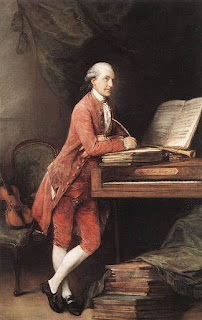MEN’S
CLOTHES ~ THE ORIGINS OF THE MODERN LOOK
18th Century England ~ 21st
Century
An English
three piece suit. Matching coat, waistcoat and Pantaloons. Thomas Gainsborough,
1780.
It was not in France, but Britain that the classic
style of clothes worn by men today began to evolve.
During the Georgian period, upper-class Englishmen
were busy running their country estates.
They needed fabrics which supported their sports, travel and life in the
countryside.
Surprisingly, the French, who
remained in court and dressed accordingly, came to admire the sensible dress of
the English. And in the 1780s, France became obsessed with all things English.
This frenzy was known as Anglomania.
Sir Walter Scott describes it well: “France, who had
so long dictated to all Europe in matters of fashion, seemed now herself
disposed to borrow the more simple forms and fashions of her ancient rival.”
Aside from the adoption of English butlers,
carriages, dogs and horses, the French began to use wool for jackets instead of
the traditional silks and satins. The French Revolution influenced this, with
the turning away from aristocratic forms of dress for both men and women.
This resulted also in a turning away from bright
colors for men. The colors of jackets were limited to brown, grey, dark green,
blue and black. Blue was acceptable for any occasion, and black reserved for
morning (informal) or for evening wear.
Boots became de rigueur. There is a wide range
of acceptable boots for daywear and riding with a low heel. Regency men did not
wear heels like their fathers and grandfathers did.
Pantaloons were skin tight and worn with gleaming Hessians. The colors were predominantly light-colored: yellow, biscuit, buff
and fawn. Normally they were one plain color, but sometimes pin-striped.
Materials were wool, cashmere, corduroy, cotton, linen, leather and silk with satin
and velvet for formal occasions.
Breeches were worn with Hessians or half boots, but
never with top boots. By the 1820s trousers of a knitted material, (inexpressibles)
became the dominant item of clothing for men instead of breeches and pantaloons.
Light colored, they were made of nankeen or jean fitting closely to the leg,
but cut wide at the ankle. They could be worn with half-boots, boots or shoes.
Waistcoats were the
main item used for color and variety. Sometimes two waistcoats were worn
simultaneously to show contrasting colors. They were made in a variety of
fabrics and often exhibited expensive embroidery. Many wore white or flesh
colored waistcoats to give the impression, should the man remove his coat, that
he was naked. Influenced by the Grecian Ideal, men were proud of their bodies
and sought by fair means or foul (a little padding or corsetry) to display them
at their best.
Gentleman’s Garrick greatcoat and hessian
boots.
Lady Lyttelton writes of the Barouche Club gentry in a letter in 1810:
‘a set of hopeless young men who think of no earthly thing but how to make
themselves like coachmen … have formed themselves into a club, inventing new
slang words, adding new capes to their great-coats and learning to suck a quid
of tobacco and chew a wisp of straw
 |
| Sense and Sensibility. The Three-Piece suit wasn't favored in the Regency Era. |
.jpg)
Under the influence of Beau Brummel, shirts were
white linen and clothing for day wear was a tightly fitting, dark-coloured tailcoat with non-matching (usually pale) trousers, pale waistcoat,
white shirt and cravat and tall boots.
The cravat which required several meters of expensive cotton was a great symbol of flair and individuality. Tying it took a
considerable amount of time and assistance. These were predominantly white, although some
striped fabrics were used, similar to ties worn today.
The
Beau.
By the Regency era, cleanliness became an important
factor - again the Beau's influence - and white fabrics demonstrated that the wearer’s clothing was clean. Regular
bathing and the use of soap replaced the heavy use of perfume to disguise body
odor.
The movement away from powder, perfume wigs, silks,
lace, embroidery and stockings segregated the fashions of men and women to
become more like our modern day understanding of menswear and masculinity,
through the many changes during the Victorian and Edwardian periods.
This tall, stiff-crowned Victorian hat has a rolled-edge brim; worn in black silk with white
tie, also worn in gray felt with black band with morning dress.
Robert Pattinson wears the Victorian version of the three-piece-suit
A contemporary three-piece suit. A Victorian groom wears the frock coat.
A groom’s attire today - a version of
the frock coat.
Website: http://www.maggiandersenauthor.com
Twitter: @maggiandersen
Facebook: Maggi Andersen Author
Sources:
Georgette
Heyer’s Regency World, Jennifer Kloester.
Napoleon
and the Empire of Fashion, Skira.
Fashion
in the time of Jane Austen, Sarah Jane Downing, Shire Library.







.jpg)
.jpg)




No comments:
Post a Comment